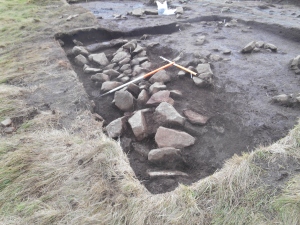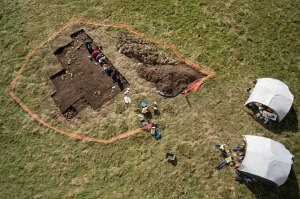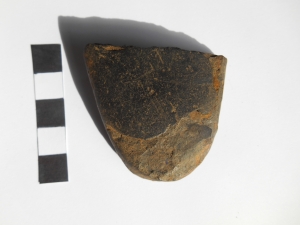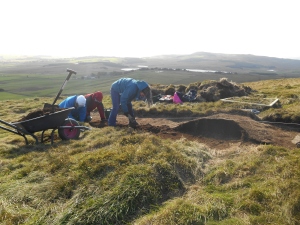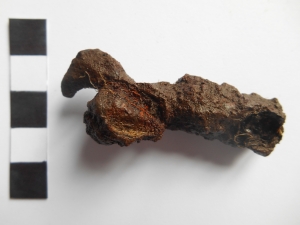Welcome back to our dig blog.
Well the dig at East Lomond Hill has now come to a close. This post is to update you about the final week of discoveries:
Day 13
College students from SRUC Oatridge joined the dig team for today. They had tour of the site and had a go at digging for the afternoon. With the increased numbers Callum our site supervisor opened a small trial-trench (our final of the season) at the north-east of the site to investigate a long terrace feature located in this area to investigate if this is part of the hillfort’s defences. Large annexes can form part of Early Medieval forts that have been shown to adapted existing Iron Age fortification. The rest of the group continued to reveal a floor level in trench A, which has been subdivided into quadrants.
Day 14
Today the dig welcomed Henrick a pupil from Glenalmond College who is interested in a career in archaeology and had a day learning field skills. A series of stone-settings were reveled in trench A associated with late prehistoric finds. These feature may be post-setting linked to the large wall at the south side of the trench, but there density would seem to suggest more than one phase of building. At the south-east corner of trench A removal of a subsoil revealed a new cut feature with substantial burnt deposits on the surface, large fragments of slag and fired clay. This looks like remains of metal-working site. This feature was close by a small wall or drain and the large stone ‘box’ setting.
Day 15
The weather closed in on us this morning. This meant our first lost hours to rain – not bad for an September/October dig. To make the most of our time the team took shelter at Falkland Centre for Stewardship, who kindly let us use their facilities to do some much-needed finds processing. This was helpful as it helped remind us just how much burnt bone was coming out of the site and a small fragment of worked flint was found in one of the general finds trays, which is always nice to see as a background indicator of prehistoric activity in the area, but was not from a well stratified layer. The clouds dispersed in the afternoon and allowed the team to get back on site for some recording.
Day 16
This was planning day when we set about fully recoding all the exposed building remains and features in trench A. Trench B to the south was excavated further to reveal a rather nice stone-lining at the base of the bank, below which was a clay and burnt soil deposit, which we should get a radiocarbon date from. Our aim in these closing days of the dig was to complete the recording of the layers we’ve got down to as the complexity of the remains meant we could not hope to resolve everything during this season. The responsible thing to do at this stage was to record what we’ve found rather than dig too much. In this way the dig has provided a useful evaluation of the area. On a site as big as East Lomond Hillfort is the most sensible approach for this the first season of a community dig.
Day 17
Our last day of archaeology for our volunteers. East Lomond saw us off with a fine day of weather. In trench C, Callum and Sue discovered a ditch and the tumbled remains of a wall or rampart. A fantastic find, which shows the hillfort was much larger than previously thought. Samples for dating from the ditch may show this was part of an Early Medieval Pictish annexe enclosing the southern shoulder of the hill. This ditched-outwork is different in character from the bank in trench B, which might instead connect to a similar upstanding section of bank visible further down the slope from trench C. If so then the hillfort may have a series of encloses adjoining its southern side. Figuring out the chronological sequences of these enclosures will be a major new find from the dig. In trench A the final discoveries were another section of wall similar in character to the smaller wall by the stone ‘box’ feature. This smaller wall was shown in section to be later than the larger faced wall, which we could now see had been truncated (cut away) at its east end. The ‘box’ feature contained burnt bone and was lined with coloured sandstone slabs, the intepretation of which will require further research for comparable features, though we are fairly confident this isn’t a burial cist and may be related to industiral activity. Also a fragment of a large rotary quern was identifed in the floor surface at the north-west side of trench A.
Closing thoughts
After all the planning and section drawings and photography were completed, the picture to emerge in trench A looked increasingly like a complex series of multi-phase settlement remains and industrial activity. Happily this is exactly the kind of sequence that we might reasonably expect to find in a well-preserved interior of a multi-phase hillfort annexe. That said very few Iron Age to Early Medieval fortified sites have been excavated in this part of Scotland, particularly in the areas inside the fortifications rather than focusing on the ramparts and walls. The post-excavation will start to build up a clearer picture of the story we have uncovered at East Lomond, but the current interpretation is that we have discovered the remains of a large Iron Age building, which was partially removed during a later period (perhaps the 1st millennium AD) to make way for a smaller series of stone structures and a metal-working site. Moreover the wider settlement terrace on the southern shoulder of the hill was enclosed by at least two boundaries (one ditched, the other a lined bank) to form annexes to the hillfort, perhaps also during the 1st millennium AD. The site is now being back filled with community payback assistance.
These excavation has been a fantastic achievement only made possible by the amazing efforts of local community volunteers. Well done to everyone who took part! Thanks for all your hard work and good company up the hill. Thanks to our funders, the Heritage Lottery Fund, Historic Scotland and the New Park Trust. Our appreciation also goes to Falkland and Balbirnie Estates and Fife Coastal and Countryside Trust. This event was delivered by Dr Oliver O’Grady of OJT Heritage for the Living Lomonds Landscape Partnership.
The Discover the Ancient Lomonds Project has enjoyed over 200 days of volunteer help this year. We are incredibly grateful to all those who have given up their spare time to take part, to learn more about archaeology and help conserve their local historic landscape. Thank you!

Discover the Ancient Lomonds! Young volunteers take part in the dig with views of Glenrothes behind.
Keep an eye on the Living Lomonds Facebook page and website for news of exciting feedback and heritage events coming soon.
All the best for now.
Funders:




